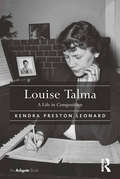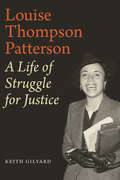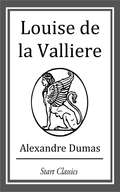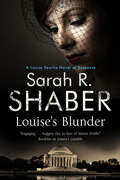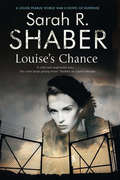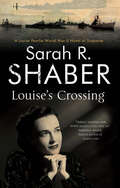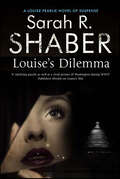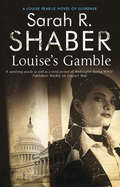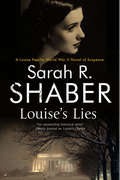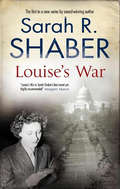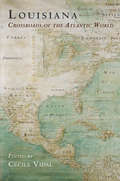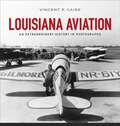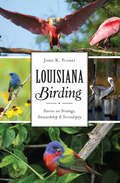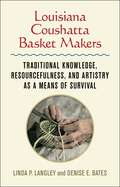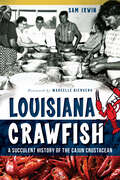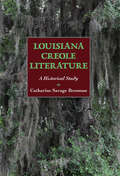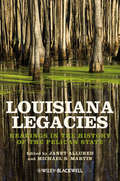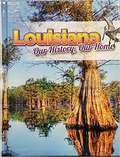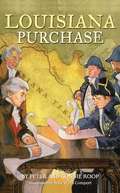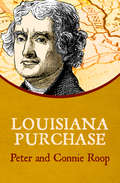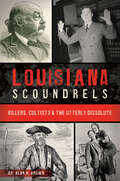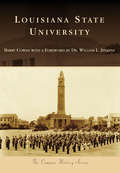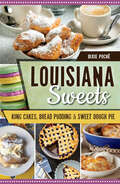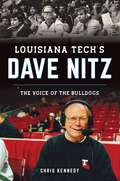- Table View
- List View
Louise Talma: A Life in Composition (Cms Monographs And Sourcebooks In American Music Ser.)
by Kendra Preston LeonardAmerican composer Louise Talma (1906-1996) was the first female winner of two back-to-back Guggenheim Awards (1946, 1947), the first American woman to have an opera premiered in Europe (1962), the first female winner of the Sibelius Award for Composition (1963), and the first woman composer elected to the American Academy and Institute of Arts and Letters (1974). This book analyses Talma’s works in the context of her life, focusing on the effects on her work of two major changes she made during her adult life: her conversion to Catholicism as an adult, under the guidance of Nadia Boulanger, and her adoption of serial compositional techniques. Employing approaches from traditional musical analysis, feminist and queer musicology, and women’s autobiographical theory to examine Talma’s body of works, comprising some eighty pieces, this is the first full-length study of this pioneering composer. Exploring Talma’s compositional language, text-setting practices, and the incorporation of autobiographical elements into her works using her own letters, sketches, and scores, as well as a number of other relevant documents, this book positions Talma’s contributions to serial and atonal music in the United States, considers her role as a woman composer during the twentieth century, and evaluates the legacy of her works and career in American music.
Louise Thompson Patterson: A Life of Struggle for Justice
by Keith GilyardBorn in 1901, Louise Thompson Patterson was a leading and transformative figure in radical African American politics. Throughout most of the twentieth century she embodied a dedicated resistance to racial, economic, and gender exploitation. In this, the first biography of Patterson, Keith Gilyard tells her compelling story, from her childhood on the West Coast, where she suffered isolation and persecution, to her participation in the Harlem Renaissance and beyond. In the 1930s and 1940s she became central, along with Paul Robeson, to the labor movement, and later, in the 1950s, she steered proto-black-feminist activities. Patterson was also crucial to the efforts in the 1970s to free political prisoners, most notably Angela Davis. In the 1980s and 1990s she continued to work as a progressive activist and public intellectual. To read her story is to witness the courage, sacrifice, vision, and discipline of someone who spent decades working to achieve justice and liberation for all.
Louise de la Valliere
by Alexandre DumasThe final volume of D'Artagnan Romances: it is usually split into four parts, The Vicomte de Bragelonne, Ten Years Later, Louise de la Valliere, and the final portion is entitled The Man in the Iron Mask.
Louise's Blunder: A 1940s Spy Thriller Set In Wartime Washington (The Louise Pearlie World War II Novels of Suspense #4)
by Sarah R. ShaberGovernment girl Louise is blackmailed into investigating the suspicious death of a missing co-worker, with sinister consequences. 1940s Washington, DC, government girl Louise Pearlie is asked to review the file usage of a missing analyst from the Office of Strategic Services—the US wartime intelligence agency—only to learn he&’d drowned in the Tidal Basin days before. OSS confirm it was an accident, and Louise is sent back to her regular job in the file rooms. Her time spent investigating Paul Hughes at least has one positive outcome, though: Louise meets a young woman in the OSS Reading Room, who asks her to join her &“salon,&” where she is encouraged to talk about controversial issues like racial segregation and equal pay for women. Socializing with the women helps her cope with her beau Joe Prager&’s transfer to New York City. But Louise&’s life soon takes a dangerous and sinister turn, and she can&’t help but worry if she&’ll wind up floating in the Tidal Basin herself . . . &“A solid and suspenseful story . . . This series keeps getting better.&” —Booklist
Louise's Chance: A 1940s Spy Thriller Set In Wartime Washington (The Louise Pearlie World War II Novels of Suspense #5)
by Sarah R. ShaberGovernment girl Louise gets her big chance, when she is tasked with recruiting German POWs for a secret mission inside Nazi Germany. 1940s Washington, DC, government girl Louise Pearlie has a new job inside the OSS—the Office of Strategic Services: recruiting German prisoners-of-war for a secret mission inside Nazi Germany. It&’s a big chance for her, and Louise hopes she can finally escape her filing and typing duties. With the job comes two new colleagues: Alice Osborne, a propaganda expert, and Merle Ellison, a forger from Texas who just happens to speak fluent German. But when the three arrive at Fort Meade camp, to interview the first German POWs to arrive there, their mission is beset by complications. Only one of the prisoners speaks English, the army officer in charge of the camp is an alcoholic and two prisoners disappeared on the ship bringing the Germans to the states. Were their deaths suicide? Officially, yes. But Louise can&’t help but have her doubts . . . &“A fine example of the historical mystery . . . The whodunit is well-crafted, with enough red herrings to keep readers guessing.&” —Star News Online &“As usual, Shaber provides interesting period details&” —Publishers Weekly
Louise's Crossing (The Louise Pearlie World War II Novels of Suspense #7)
by Sarah R. ShaberGovernment girl Louise Pearlie is thrilled to be posted to London, but her journey across the Atlantic proves to be anything but plain sailing…February, 1944. Washington D.C. With the war entering its most dangerous phase, Louise Pearlie is thrilled to be reassigned to the London office of the OSS. But in order to take up her new post, she must make a perilous crossing of the Atlantic Ocean in the SS Amelia Earhart. Accompanying her on the voyage to Liverpool are an eclectic group of passengers, including the aloof Blanche Bryant, whose husband, Eddie, died in mysterious circumstances on the ship’s voyage out to New York three months before. Most of the same crew and passengers are on the return voyage, and one question remains: was it really suicide? When the body of one of the passengers is found on deck, it’s clear that German bombs and raging storms aren’t the only threats to Louise’s safety. Can she expose a brutal killer before the ship docks in England?
Louise's Dilemma (The Louise Pearlie World War II Novels of Suspense #3)
by Sarah R. ShaberThe third book in the Louise Pearlie Mysteries is &“an entertaining combination of mystery, adventure, and romance, with a great sense of place and time&” (Historical Novel Society). Young widow Louise Pearlie seizes a chance to escape the typewriters and files of the Office of Strategic Services, the United States&’ World War II spy agency, when she&’s asked to investigate a puzzling postcard referred to OSS by the US Censor. She and FBI agent Gray Williams head off to St. Leonard, Maryland, to talk to the postcard&’s recipient, one Leroy Martin. But what seemed like a straightforward mission to Louise soon becomes complicated. Leroy and his wife, Anne, refuse to talk, but as Louise and Williams investigate, it soon becomes clear that Leroy is mixed up in something that looks a lot like treason. But what? Louise is determined to find out the truth, whatever the cost . . . &“A very good entry in this new and promising series.&” —Booklist
Louise's Gamble (The Louise Pearlie World War II Novels of Suspense #2)
by Sarah R. ShaberYoung widow Louise Pearlie becomes embroiled in a perilous game of mafia bosses, Nazi spies, and banished royalty in this wartime novel of suspense. It&’s 1942 in Washington, DC. Louise Pearlie is now a chief file clerk at the legendary Office of Strategic Services, the precursor to the CIA, and enjoying being an independent, working woman despite wartime privations. But a casual friendship struck up with Alessa di Luca, a secretive war refugee, sucks Louise into a dangerous game of mafia bosses, Nazi spies, banished royalty, and Sicilian aristocracy—placing not only her job, but her life, in jeopardy . . . &“Shaber brews a delightful mix of feminine wiles and real-life history that will keep readers turning the pages.&” —Publishers Weekly &“Shaber has created a wonderful cast of characters . . . A wonderfully entertaining read.&” —Historical Novel Society
Louise's Lies: A 1940s Spy Thriller Set In Wartime Washington D. C. (The Louise Pearlie World War II Novels of Suspense #6)
by Sarah R. Shaber&“Shaber&’s winning sixth WWII mystery is her best yet&”—from the award-winning author of Louise&’s Chance and Louise&’s Crossing (Publishers Weekly, starred review). When a body is discovered in a Washington bar, government girl Louise Pearlie is forced into a role of lies and deception. On a bitterly cold night in December 1943, Louise Pearlie and her friend Joe Prager are enjoying a quiet drink in the Baron Steuben Inn when a bloodstained body is discovered behind the bar. Although the victim had been a regular customer, no one seems to know anything about him. When it turns out there is a link to Louise&’s top-secret work at the OSS, she is ordered to find out as much as possible about the murder while keeping the connection secret from those involved, including the investigating police detective. Although Louise has been trained to keep secrets, the constant deception is taking its toll—especially when she discovers that she&’s not the only customer at the Steuben that night with something to hide. Will Louise&’s silence result in an innocent man being arrested for murder? &“[Louise&’s] sixth adventure is a worthy addition to the franchise.&”—Kirkus Reviews &“Shaber does a fine job portraying the plight of alien residents in wartime Washington, besides conveying the hectic atmosphere of a city whose resources are stretched to the limit by an influx of new workers.&”—Publishers Weekly (starred review)
Louise's War (The Louise Pearlie World War II Novels of Suspense #1)
by Sarah R. ShaberThe first book in the Louise Pearlie Mysteries is &“Sarah Shaber&’s best novel yet&” (Margaret Maron). It&’s 1942. Louise Pearlie, a young widow, has come to Washington, DC to work for the legendary Office of Strategic Services, the precursor to the CIA. When she discovers a document concerning the husband of her college friend Rachel Bloch—a young French Jewish woman she is desperately worried about—Louise realizes she may be able to help Rachel escape from Vichy France. But then a colleague whose help Louise has enlisted is murdered, and she realizes she is on her own, unable to trust anyone . . . &“A satisfying puzzle as well as a vivid picture of Washington during WWII.&” —Publishers Weekly &“An auspicious debut.&” —Library Journal
Louisiana
by Cecile VidalLocated at the junction of North America and the Caribbean, the vast territory of colonial Louisiana provides a paradigmatic case study for an Atlantic studies approach. One of the largest North American colonies and one of the last to be founded, Louisiana was governed by a succession of sovereignties, with parts ruled at various times by France, Spain, Britain, and finally the United States. But just as these shifting imperial connections shaped the territory's culture, Louisiana's peculiar geography and history also yielded a distinctive colonization pattern that reflected a synthesis of continent and island societies.Louisiana: Crossroads of the Atlantic World offers an exceptional collaboration among American, Canadian, and European historians who explore colonial and antebellum Louisiana's relations with the rest of the Atlantic world. Studying the legacy of each period of Louisiana history over the longue durée, the essays create a larger picture of the ways early settlements influenced Louisiana society and how the changes of sovereignty and other circulations gave rise to a multiethnic society. Contributors examine the workings of empires through the examples of slave laws, administrative careers or on-the-ground political negotiations, cultural exchanges among masters, non-slave holders, and slaves, and the construction of race through sexuality, marriage and household formation. As a whole, the volume makes the compelling argument that one cannot write Louisiana history without adopting an Atlantic perspective, or Atlantic history without referring to Louisiana.Contributors: Guillaume Aubert, Emily Clark, Alexandre Dubé, Sylvia R. Frey, Sylvia L. Hilton, Jean-Pierre Le Glaunec, Cécile Vidal, Sophie White, Mary Williams.
Louisiana Aviation: An Extraordinary History in Photographs
by Vincent P. CaireAt the beginning of the twentieth century the skies presented a new frontier, one that attracted daredevils, businessmen, politicians, and engineers enticed by a new form of transportation. Louisiana entrepreneurs and pilots proved instrumental in ushering in the Golden Age of Aviation. They advanced aircraft design, revolutionized aerial crop dusting, pioneered airmail routes, pushed the limits of stunt flying, and entertained spectators with air races. A pilot and freelance writer with more than twenty years of experience in the aviation industry, Vincent P. Caire chronicles the state's history of flight in 196 vintage and contemporary photographs, many never-before published. Photos of early aviation pioneer John Moisant, air racing champion General James Doolittle, barnstormer Roscoe Turner, aircraft designer James Wedell, and founder of Delta Airlines C. E. Woolman reflect Louisiana's zeal for aeronautics. Caire explains how the efforts of Senator Huey P. Long and Harry P. Williams, co-owner of the Wedell-Williams Air Service in Patterson, Louisiana, influenced the development of viable airmail routes throughout the southeastern United States. Rarely seen photographs depict the Art Deco elegance of the first modern, multioperational passenger terminal in the nation -- Shushan Airport in New Orleans.A captivating visual tour spanning one hundred years, Louisiana Aviation celebrates the state's air history, evident in Louisiana's seventy airports, 5,000 aircraft, 7,000 pilots, and numerous airshows in operation today.
Louisiana Birding: Stories on Strategy, Stewardship & Serendipity (Natural History)
by John K. FloresFrom the bayous of the coast to prairies and rolling hills, Louisiana is home to a vibrant and thriving avian population. Herons, American goldfinches, snow geese and more call the state coastline home during the winter months. The music of neotropic songbirds like the parula and the prothonotary warbler fills the bayous every spring morning. Endangered species like the whooping crane and brown pelican have been reintroduced to the state to great success. The pragmatic conservation efforts of state, federal and private agencies not only led to the successful delisting of some endangered species of birds but also helped develop protocols for the future stewardship of others. Award-winning outdoor writer and photographer John Flores celebrates Louisiana's notable feathered inhabitants in their natural habitats.
Louisiana Coushatta Basket Makers: Traditional Knowledge, Resourcefulness, and Artistry as a Means of Survival
by Denise E. Bates Linda LangleyLouisiana Coushatta Basket Makers brings together oral histories, tribal records, archival materials, and archaeological evidence to explore the fascinating history of the Coushatta Tribe’s famed basket weavers. After settling at their present location near the town of Elton, Louisiana, in the 1880s, the Coushatta (Koasati) tribe developed a basket industry that bolstered the local tribal economy and became the basis for generating tourism and political mobilization. The baskets represented a material culture that distinguished the Coushattas as Indigenous people within an ethnically and racially diverse region. Tribal leaders serving as diplomats also used baskets as strategic gifts as they built political and economic allegiances throughout the twentieth century, thereby securing the Coushattas’ future.Behind all these efforts were the basket makers themselves. Although a few Coushatta men assisted in the production of baskets, it was mostly women who put in the long hours to gather and process the materials, then skillfully stitch them together to produce treasures of all shapes and sizes. The art of basket making exists within a broader framework of Coushatta traditional teachings and educational practices that have persisted to the present.As they tell the story of Coushatta basket makers, Linda P. Langley and Denise E. Batesprovide a better understanding of the tribe’s culture and values. The weavers’ own “language of baskets” shapes this narrative, which depicts how the tribe survived repeated hardships as weavers responded on their own terms to market demands. The work of Coushatta basket makers represents the perseverance of traditional knowledge in the form of unique and carefully crafted fine art that continues to garner greater recognition and appreciation with every successive generation.
Louisiana Crawfish: A Succulent History of the Cajun Crustacean (American Palate)
by Sam IrwinThe hunt for red crawfish is the thing, the raison d'etre, of Acadian spring. Introduced to Louisiana by the swamp dwellers of the Atchafalaya Basin, the crawfish is a regional favorite that has spurred a $210 million industry. Whole families work at the same fisheries, and annual crawfish festivals dominate the social calendar. More importantly, no matter the occasion, folks take their boils seriously: they'll endure line cutters, heat and humidity, mosquitoes and high gas prices to procure crawfish for their families' annual backyard boils or their corporate picnics. Join author Sam Irwin as he tells the story--complete with recipes and tall tales--of Louisiana's favorite crustacean: the crawfish.
Louisiana Creole Literature: A Historical Study
by Catharine Savage BrosmanLouisiana Creole Literature is a broad-ranging critical reading of belles lettres—in both French and English—connected to and generally produced by the distinctive Louisiana Creole peoples, chiefly in the southeastern part of the state. The book covers primarily the nineteenth and twentieth centuries, the flourishing period during which the term Creole had broad and contested cultural reference in Louisiana. The study consists in part of literary history and biography. When available and appropriate, each discussion—arranged chronologically—provides pertinent personal information on authors, as well as publishing facts. Readers will find also summaries and evaluation of key texts, some virtually unknown, others of difficult access. Brosman illuminates the biographies and works of Kate Chopin, Lafcadio Hearn, George Washington Cable, Grace King, and Adolphe Duhart, among others. In addition, she challenges views that appear to be skewed regarding canon formation. The book places emphasis on poetry and fiction, reaching from early nineteenth-century writing through the twentieth century to selected works by poets still writing in the early twenty-first century. A few plays are treated also, especially by Victor Séjour. Louisiana Creole Literature examines at length the writings of important Francophone figures, and certain Anglophone novelists likewise receive extended treatment. Since much of nineteenth-century Louisiana literature was transnational, the book considers Creole-based works which appeared in Paris as well as those published locally.
Louisiana Legacies: Readings in the History of the Pelican State (Coursesmart Ser.)
by Janet Allured Michael S. MartinShowcasing the colorful, even raucous, political, social, and unique cultural qualities of Louisiana history, this new collection of essays features the finest and latest scholarship. Includes readings featuring recent scholarship that expand on traditional historical accounts Includes material on every region of Louisiana Covers a wide range of fields, including social, environmental, and economic history Detailed, focused material on different areas in Louisiana history, including women’s history as well as the state’s diverse ethnic populations
Louisiana Poets: A Literary Guide
by Catharine Savage Brosman Olivia McNeely PassLouisiana has long been recognized for its production of talented writers, and its poets in particular have shined. From the early poetry of the state to the work crafted in the present day, Louisiana has nurtured and exported a rich and diverse poetic tradition. In Louisiana Poets: A Literary Guide authors Catharine Savage Brosman and Olivia McNeely Pass assess the achievements of Louisiana poets from the past hundred years who, Brosman and Pass assert, deserve both public notice and careful critical examination.Louisiana Poets presents the careers and works of writers whose verse is closely connected to the peoples, history, and landscapes of Louisiana or whose upbringing or artistic development occurred in the state. Brosman and Pass chose poets based on the scope, abundance, and excellence of their work; their critical reception; and the local and national standing of the writer and work. The book treats a wide range of forty poets—from national bestsellers to local celebrities—detailing their histories and output.Intended to be of broad interest and easy to consult, Louisiana Poets showcases the corpus of Louisiana poetry alongside its current profile. Brosman and Pass have created a guide that provides a way for readers to discover, savor, and celebrate poets who have been inspired in and by the Pelican State.
Louisiana Purchase
by Peter Roop Connie RoopIn 1803 President Thomas Jefferson bought the Louisiana territory from the French for $15,000,000. The purchase made President Jefferson's dream of extending the U.S. west of the Mississippi River come true. Now the much larger United States had difficult questions to answer: How would Louisiana be governed? How would it be divided into states? Would those states be free states or slave states? What would happen to the Native Americans? It would take over one hundred years, a war over slavery, and the creation of thirteen new states before these questions could be answered.
Louisiana Purchase
by Peter Roop Connie RoopThe big purchase that led to fundamental questions about what America would become In 1803 President Thomas Jefferson bought the Louisiana Territory from the French for $15 million, extending the United States beyond the Mississippi River for the first time. Now the United States had big questions to answer: How would Louisiana be governed? How would it be divided? Would it be comprised of free states or slave states? What would happen to the Native Americans? With biographical sketches of the people who helped forge the answers to these questions, such as Lewis and Clark, Napoleon Bonaparte, and of course, Thomas Jefferson, this is the tale of the expansion of the United States into a new territory as well as a new era.
Louisiana Scoundrels: Killers, Cultists & the Utterly Dissolute
by Dr Alan N. BrownAuthor Alan Brown guides the intrepid on a dark tour of the Pelican State’s most infamous residents. Louisiana beckons those the world over with its culture and Spanish moss–draped beauty. But that magnetic pull has also summoned a cast of reprobates vile enough to fill a book. In this version of Louisiana, pirate Jean Lafitte and gentlemanly train robber Eugene Bunch go ahead and help themselves to whatever they like, murderous dentist Etienne De Champs is the stuff of dentophobic nightmares, a psychotic killer known as “The Axeman” stalks the streets of New Orleans and a hail of bullets greets Bonnie and Clyde. Indeed, the sadistic Delphine LaLaurie and Voodoo Queen Clementine Barnabet are quite comfortable in this decidedly non-moss-draped history.
Louisiana State University
by Dr William Jenkins Barry CowanLouisiana State University began in 1860 as a small, all-male military school near Pineville. The institution survived the Civil War, Reconstruction politics, and budgetary difficulties to become a nationally and internationally recognized leader in research and teaching. A devastating fire destroyed the campus in 1869, and the school moved to Baton Rouge, where it has remained. Successive moves to larger campuses in 1887 and 1925 created greater opportunities in academics, student life, and athletics. Academics began with classical and engineering courses. New majors in the arts, literature, engineering, agriculture, and the sciences evolved, along with research in those fields. Student life changed from military regimentation to coeducation and students' freedom to live off campus and make their own decisions. Intercollegiate athletics began in 1893 with baseball and football games against Tulane, and the LSU Tigers have since won numerous championships. These evolutionary steps all helped to create Louisiana's flagship university.
Louisiana Sweets: King Cakes, Bread Pudding, & Sweet Dough Pie (American Palate Ser.)
by Dixie PochéExplore the recipes and history behind an array of sweet treats from the Sugar State with help from the author of Classic Eateries of Cajun Country.Louisiana is famous for its culinary delights, and the state&’s rich medley of treats and confections proves its sweet tooth. Creative bakers improvised traditional recipes during days of rationing to create gateau de sirop (syrup cake) and bread pudding. Early customers of Lea&’s Lunchroom&’s pies in central Louisiana included outlaws Bonnie and Clyde, who dropped by while they were on the run. During the 1950s, singers Hank Williams Sr. and Elvis Presley hung out at Shreveport&’s Southern Maid Donuts after performing at the popular Louisiana Hayride country music broadcast. Author Dixie Poché dives into the recipes and history behind such beloved regional specialties as Mardi Gras king cake, flaming Bananas Foster, Cajun Country&’s pain perdu and many more.&“Desserts Past, Present, and Future are the stars of Dixie Poché&’s new book, Louisiana Sweets: King Cakes, Bread Pudding, and Sweet Dough Pie. The Lafayette-based travel writer gets rather Dickensian (but trade that tacky soot for powdered sugar) as she lays outs a picture of the state&’s love affair with sweets through history, anecdotes, recipes, restaurant profiles, and more.&” —Country Roads Magazine
Louisiana Tech's Dave Nitz: The Voice of the Bulldogs (Sports)
by Chris KennedyAuthor Christopher A. Kennedy shares the story of the Voice of the Bulldogs. Dave Nitz was the voice of Louisiana Tech University sports for half a century, his distinctive voice emanating from Tech fans’ radios. A West Virginia native, Nitz dreamed of broadcasting in the big leagues. Little did he know that his Hall of Fame broadcasting career would take him to Ruston, Louisiana. Along the way, Nitz worked with country music icon Tom T. Hall in West Virginia and covered William & Mary University football under Lou Holtz. At Tech, Nitz gave voice to the basketball greatness of Karl “The Mailman” Malone and the national champion Lady Techsters. He called gridiron action from Maxie Lambright through unforgettable upsets of Alabama and Michigan State. Author Christopher A. Kennedy shares the story of the Voice of the Bulldogs. As Nitz would say, “You gotta love it!”
